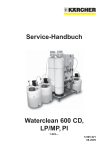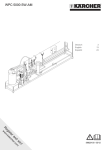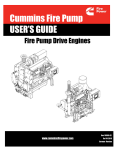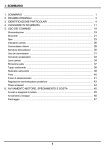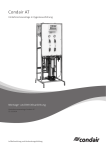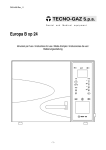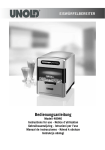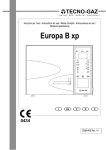Download Karcher A 2011201 User's Manual
Transcript
Betriebsanleitung WATERCLEAN 600 LP / MP BTA 5.960-505.0 ETL 5.970-054.0 (LP 400V) 5.970-055.0 (MP 400V) 5.970-156.0 (LP 230V) 5.970-157.0 (MP 230V) A 2011201 WTC 600 LP / MP Version 06/05 18 5 6 7 19 4 3 8 9 10 11 12 13 14 15 2 16 17 1 2 20 WTC 600 LP / MP Inhaltsverzeichnis 1 2 3 3.1 3.1.1 3.1.2 3.1.3 3.1.4 3.2 3.2.1 3.2.2 3.2.3 3.2.4 3.2.5 3.2.6 3.3 Sicherheitshinweise................................3 Bestimmungsgemäßer Gebrauch ..........3 Bedienung und Pflege ............................4 Inbetriebnahme ......................................4 Vordruckeinheit ......................................4 Dosierstationen befüllen.........................4 Anlage einschalten .................................5 Betriebsanzeigen....................................5 Während des Betriebes..........................5 Kontroll- und Aufgabenintervalle ............5 Sand- und Aktivkohlefilter.......................6 Dosierpumpe entlüften ...........................6 Feinfilter wechseln..................................7 Feinregulierung der Betriebsdrücke .......7 Chemie anmischen.................................8 Anlage ausschalten ................................9 4 5 6 7 Verbrauchsmaterial ................................9 Störungen.............................................10 Technische Daten ................................11 EG Konformitätserklärung ....................12 Anlagenelemente 1 2 3 4 5 6 7 8 9 10 11 12 13 14 15 16 17 18 19 20 Sicherheitshinweise Version 06/05 Sandfilter Aktivkohlefilter Steuerung Aktivkohlefilter Steuerung Sandfilter Manometer Eingangsdruck Sandfilter Manometer Eingangsdruck Aktivkohlefilter RO-Filtereinheit Schaltkasten Betriebsartenschalter Bedienfeld Manometer Pumpendruck Manometer Konzentratdruck Konzentratregelventil Druckregelventil Manometer Eingangsdruck Feinfilter Manometer Ausgangsdruck Feinfilter Feinfiltereinheit Steckdosen Sand- und Aktivkohlefilter Steckdosen (3x) für Dosierstationen Hauptschalter 1 Sicherheitshinweise Sicherer Betrieb der Anlage ist nur möglich, wenn Sie die Bedienungsanleitung und die Sicherheitshinweise vollständig lesen und die darin enthaltenen Anweisungen strikt befolgen. Trinkwasser ❑ Trinkwasserqualität ist nur bei fristgerechter Überwachung der Anlage gewährleistet. Beachten Sie die angegebenen Kontrollintervalle. ❑ Lassen Sie die Trinkwasserqualität in regelmäßigen Abständen überprüfen, die gültige Trinkwasserverordnung ist zu beachten. Chemikalien ❑ Benutzen Sie säurefeste Schutzkleidung (Brille und Handschuhe). ❑ Lagern Sie die Chemikalien kühl und trocken, jedoch nicht unter 5 °C. ❑ Bewahren Sie die Chemikalien an einem für Kinder unzugänglichen Ort auf. ❑ Sorgen Sie für gute Raumbelüftung und eine Waschgelegenheit. ❑ Stellen Sie eine Augenspülflasche bereit. Elektrische Anlage ❑ Lassen Sie Arbeiten an der elektrischen Anlage nur von einer Elektrofachkraft durchführen. ❑ Berühren Sie niemals beschädigte oder durchtrennte Netzkabel, ziehen sie ggf. sofort den Netzstecker. ❑ Anlage niemals mit beschädigtem Kabel betreiben. 2 Bestimmungsgemäßer Gebrauch Die Anlage wird zur Aufbereitung von Oberflächen-, Brunnen- und Flusswasser eingesetzt. Durch den modularen Aufbau kann in Abhängigkeit der Rohwasserqualität eine Abtrennung von Trübstoffen, Härtebildnern, Salzen und Bakterien/ Viren sichergestellt werden. 3 Bedienung und Pflege 3 WTC 600 LP / MP Version 06/05 Bedienung und Pflege Die Anlage darf nur in Betrieb genommen werden, wenn ein autorisierter KÄRCHER Fachhändler die Anlage aufgebaut, installiert und für den Betrieb vorbereitet hat. 3.1 Inbetriebnahme Vor der Inbetriebnahme: • Sicherstellen, dass die Anlage mit der Rohwasserquelle bzw. deren Fördereinrichtung, z. B. Vordruckeinheit, verbunden ist. • Sicherstellen, dass das Trinkwasser ungehindert in einen Tank oder eine geeignete nutzerseitige Einrichtung fließen kann. Das Trinkwasser muss ohne Gegendruck abfließen können. Die Höhendifferenz darf 3 m nicht übersteigen. 3.1.1 i Falls eine Vordruckeinheit erforderlich ist, wird diese betriebsbereit vom Kärcher Servicetechniker installiert. 23 24 25 26 21 4 3.1.2 Dosierstationen befüllen Ist die Anlage mit einer oder mehreren Dosierstationen ausgestattet, muss sichergestellt sein, dass diese korrekt befüllt und angeschlossen sind. i • Schutzkleidung anlegen. • Deckel (27) der Dosierstation (30) öffnen. Vordruckeinheit Die Vordruckeinheit besteht aus einer Pumpe (21) und einem Steuergerät (22). Der Betriebszustand der Pumpe wird mit drei Leuchten angezeigt • grün (24): betriebsbereit • gelb (25): Pumpe fördert • rot (26): Störung oder Wassermangel 22 • Die Reset Taste (23) startet die Pumpe nach einer Störung 28 29 27 30 • Entsprechende Chemikalie gemäß Vorgaben aus Abschnitt 3.2.6 in den Dosierbehälter füllen. Die Dosierstationen dürfen nicht verwechselt, d. h. mit der falschen Chemikalie befüllt werden. • Entsprechende Menge chlorfreies Trinkwasser zugeben. • Deckel der Dosierstation schließen. • Den Mischstab (28) bis zum Anschlag aus dem Dosierbehälter ziehen und wieder zurückschieben. Diesen Vorgang ca. 5 min lang wiederholen, bis die Chemikalie vollständig vermischt ist. WTC 600 LP / MP War der Dosierbehälter vollständig entleert, hat die Dosierpumpe (29) evtl. Luft angesaugt. In diesem Fall Pumpe gemäß Abschnitt 3.2.3 entlüften. 3.1.3 Anlage einschalten • Prüfen, ob die Pumpen der Dosierstationen, Sand- und Aktivkohlefilter an den entsprechenden Steckdosen (18 / 19) am Schaltkasten (8) angeschlossen sind. • Prüfen ob der Betriebsartenschalter (9) in der richtigen Position "Automatik" bzw. "Hand" steht. In der Betriebsart "Automatik" wird die Anlage von einem externen Schwimmerschalter im Trinkwassertank gesteuert. In der Betriebsart "Hand" wird die Anlage manuell über den Hauptschalter ein- und ausgeschaltet. i 3.2 Bedienung und Pflege Version 06/05 • Hauptschalter (20) in Position "I" schalten, die Anlage startet die Trinkwasserproduktion. 3.1.4 Betriebsanzeigen Display der Steuerung (3 / 4) des Sand- und Aktivkohlefilters: • Anzeige der Uhrzeit • LED Zeile: Anzeige des Wochentags Steuerung der RO-Anlage: Im zweizeiligen Display am Bedienfeld (10) der RO-Anlage wird abwechselnd angezeigt: • Anlagen-/Versionsnummer und Betriebszustand, • Trinkwassertemperatur und -leitwert, • Betriebstunden (_ _ _ _ _h _ _min). Während des Betriebes Trinkwasserqualität ist nur bei Einhaltung der nachstehenden Kontrollintervalle gewährleistet. Lassen sich Abweichungen vom Sollzustand nicht durch die angegebenen Maßnahmen beheben, muss die Trinkwasserproduktion gestoppt und der Kärcher Service verständigt werden. 3.2.1 Kontroll- und Aufgabenintervalle t…täglich, w…wöchentlich, m… monatlich Intervall Kontrolle/Tätigkeit t Füllstand Dosierbehälter Soll bei Abweichung ausreichende Befüllung auffüllen, Chemie anmischen s. Abschnitt 3.2.6 Luftblasen in Dosierleitungen keine Luftblasen Absinken des Trinkwasserflusses bis zu 10% Feinregulierung, s. Abschnitt • (1) ausgehend vom Inbetriebnahmewert Anstieg des Trinkwasserleitwerts bis zu 10% Feinregulierung, s. Abschnitt • (2) Druckdifferenz Pumpen- und Konzentratdruck max. 15% über Inbetriebnah- s. Abschnitt • (3) medifferenz Kärcher Service Betriebszähler Sand- und Aktivkohlefilter * Rückspülung hat innerhalb Kärcher Service der letzten 24 h stattgefunden Trinkwasserfluss ausgehend vom Inbetriebnahmewert Trinkwasserleitwert w Dosierpumpe entlüften, s. Abschnitt 3.2.3 Druckunterschied Feinfilter ≥ 0,8 bar Sichtkontrolle Anlage keine Undichtigkeiten Feinfilter wechseln s. Abschnitt 3.2.4 Kärcher Service Betriebsprotokoll ausfüllen 5 Bedienung und Pflege Intervall Kontrolle/Tätigkeit m WTC 600 LP / MP Version 06/05 Soll bei Abweichung Dosierbehälter reinigen und spülen Rohwasserpumpe sichtprüfen keine Beschädigungen/Undichtigkeiten erkennbar Kärcher Service Schwimmerschalter im Trink- keine Funktionsstörung wassertank erkennbar Kärcher Service * zur Umschaltung der Anzeige s. Abschnitt 3.2.2 3.2.2 Sand- und Aktivkohlefilter 33 Die Steuerung von Sand- und Aktivkohlefilter zeigt während dem Betrieb die aktuelle Uhrzeit an. Zum Wechseln der Anzeige: • Taste (32) ca. 5 s drücken, Display (31) zeigt die Uhrzeit der Regeneration an. • Taste (32) kurz drücken, Display zeigt Anzahl der Regenerationen an. • Taste (32) kurz drücken, Display zeigt Anzahl der Tage und Stunden seit letzter Regeneration an. • Nach einiger Zeit springt die Anzeige auf die aktuelle Uhrzeit zurück. 32 31 34 35 • Die Entlüftungsschraube (34) eine Umdrehung öffnen. • Taste Manuell (33) solange drücken, bis das Medium blasenfrei durch die Entlüftungsleitung (35) in den Behälter zurück läuft. • Entlüftungsschraube wieder zudrehen. production / production produccion / produzione 3.2.3 Dosierpumpe entlüften Die Dosierpumpe muss entlüftet werden, falls die Pumpe Luft angesaugt hat (z. B. weil der Dosierbehälter vollständig entleert ist). • Anlage stoppt, im Display wird die Störungsmeldung "Motor/Hartwasser" angezeigt. i Diese Fehlermeldung wird angezeigt, unabhängig davon welcher Dosierbehälter leer ist. • Leeren Dosierbehälter befüllen und Chemie gemäß Abschnitt 3.2.6 anmischen. 6 fault / default error / guasto disinfection / nettoyage desinfeccion / disinfezione reject / rejet evacuation / evacuatione regeneration / regeneration regeneracion / rigenerazione tank full / stockage plein deposito lleno / serbatoto pieno RO 1000 ESC 36 • Die Störungsmeldung am Bedienfeld mit der Taste Return (36) quittieren, die Anlage startet. WTC 600 LP / MP 3.2.4 Feinfilter wechseln Druckdifferenz am Manometer (15) und (16) prüfen. Bei mehr als 0,8 bar, Filtereinsatz wechseln: • Anlage am Hauptschalter (20) ausschalten. • Rohwasserzufuhr sperren. 15 16 37 i Die Anlage reagiert etwas zeitverzögert auf Änderungen an den Regelventilen. Deshalb die Einstellung am Druckregelventil (14) und am Konzentratregelventil (13) nur in kleinen Schritten durchführen und die jeweilige Auswirkung abwarten. (1) Trinkwasserfluss von _____ auf _____ l/h gesunken 38 Trinkwassermenge am Durchflussmesser (42) ablesen und mit dem Wert bei Inbetriebnahme vergleichen (siehe Inbetriebnahmeprotokoll). 39 Ist der Trinkwasserfluss auf _____ l/h gesunken, ist die nachstehende Feinregulierung durchzuführen. Führt die Feinregulierung zu keiner Erhöhung des Trinkwasserflusses, ist der Kärcher Service zu verständigen. 40 41 • Eimer unter den Rohwasserentnahmehahn (37) stellen und Hahn öffnen. • Warten bis kein Wasser mehr aus dem Hahn austritt, dann Hahn wieder schließen. • Filterschlüssel (41) am Filtertopf (40) ansetzen und Filtertopf abschrauben. i Bedienung und Pflege Version 06/05 • Druckregelventil (14) langsam im Uhrzeigersinn schließen, bis am Durchflussmesser (42) die Sollmenge fast erreicht ist. • Konzentratregelventil (13) langsam im Uhrzeigersinn schließen, bis an den beiden Durchflussmessern für Konzentrat (43) und Trinkwasser (42) der jeweilige Sollwert erreicht ist. • Ggf. an beiden Ventilhebeln eine Nachjustierung durchführen. Filtertopf ist noch mit Wasser gefüllt. • Den Filtereinsatz (38) aus dem Filtertopf nehmen und durch neuen ersetzen. • Vor dem Anschrauben des Filtertopfs den Dichtring (39) auf Beschädigung prüfen. • Filtertopf anschrauben und mit dem Filterschlüssel festziehen. • Rohwasserzufuhr wieder öffnen und Anlage am Hauptschalter starten. 10 42 43 11 3.2.5 Feinregulierung der Betriebsdrücke Bei Veränderungen an den Anlageneinstellungen dürfen folgende Werte keinesfalls überschritten werden: • Pumpendruck max. 21 bar (MP) bzw. 14 bar (LP) • Trinkwassermenge max. 650 l / h • Konzentratmenge darf Wert der Inbetriebnahme nicht unterschreiten 13 12 14 7 Bedienung und Pflege (2) Leitfähigkeit des Trinkwassers von _____ auf _____ µS/cm gestiegen i Kleine Erhöhungen der Trinkwasserleitfähigkeit beeinträchtigen die Trinkwasserqualität nicht. Am Display des Bedienfeldes (10) den aktuellen Leitwert des Trinkwassers ablesen und mit dem Wert bei Inbetriebnahme vergleichen (siehe Inbetriebnahmeprotokoll). Ist der Trinkwasserleitwert auf _____ µS/cm gestiegen, ist die nachstehende Feinregulierung durchzuführen. Führt die Feinregulierung zu keiner Absenkung des Trinkwasserleitwerts, ist der Kärcher Service zu verständigen. • Konzentratregelventil (13) in kleinen Schritten gegen den Uhrzeigersinn öffnen, bis die Leitfähigkeit den Sollwert erreicht hat. • Druckregelventil (14) in kleinen Schritten im Uhrzeigersinn schließen, bis die Trinkwassermenge im Schauglas (42) den Sollwert erreicht. 3.2.6 WTC 600 LP / MP Version 06/05 Hinweis: Dabei erhöht sich die Konzentratmenge gegenüber dem Startwert. Dies ist so gewollt. Maximalen Druck von 21 bar (MP) bzw. 14 bar (LP) am Manometer (11) beachten! • Einstellschritte ggf. wiederholen. Eventuell wird die ursprüngliche Trinkwassermenge nicht mehr ganz erreicht. (3) Differenz zwischen Pumpen- und Konzentratdruck mehr als _____ bar gestiegen • Die Werte am Manometer für den Pumpendruck (11) und für den Konzentratdruck (12) ablesen und den Differenzdruck ermitteln. • Den aktuellen Differenzdruck mit dem Wert bei Inbetriebnahme vergleichen (siehe Inbetriebnahmeprotokoll). Ist der Differenzdruck um mehr als _____ bar gestiegen, ist die RO-Filtermembran verstopft, eine Nachregelung ist nicht mehr möglich. Trinkwasserproduktion einstellen und Kärcher Service verständigen. Chemie anmischen Bei Arbeiten mit Chemikalien immer Schutzkleidung anlegen. i Werte für die Dosierung der verschiedenen Chemikalien ergeben sich aus der Rohwasseranalyse und der Anlagenleistung. Der Kärcher Servicetechniker trägt bei der Inbetriebnahme die für Ihre Anlage erforderlichen Dosiermengen in die nachstehende Dosiertabelle ein. (1) Dosiertabelle Dosierbehälter Chemikalie Vorchlorung Art. Nr. RM 852 Entkeimungsmittel* Calciumhypochlorit * 6.291-772.0 6.291-505.0 Vorflockung Ferrifloc Anti Scalant RM 5000 Härtestabilisierung 6.290-991.0 * 6.291-772.0 Nachchlorung 6.294-703.0 RM 852 Entkeimungsmittel Calciumhypochlorit * 6.291-505.0 * Diese Chemikalien können jeweils alternativ verwendet werden 8 Dosierung der Chemikalie [ml] pro 10 l Dosierlösung WTC 600 LP / MP (2) Dosierung Zum Anmischen der Chemikalie darf nur unchloriertes Trinkwasser verwendet werden. Dieses Wasser wird am Trinkwasserprobenahmehahn (44) entnommen. 44 Teilentleerter Dosierbehälter: • Mit Hilfe der Skala am Dosierbehälter den Flüssigkeitsstand ablesen, z.B. 35 l. • Die Nachfüllmenge ermitteln, dazu von 75 l den abgelesenen Füllstand abziehen. Im Beispiel: 75 l - 35 l = 40 l. • Aus der Dosiertabelle die erforderliche Menge der entsprechenden Chemikalie ermitteln. Im Beispiel: 4 x die Menge für 10 l Wasser. • Die ermittelte Menge der entsprechenden Chemikalie abmessen und in den Dosierbehälter füllen. • Wassernachfüllmenge bis zur Markierung "75 l" auffüllen und gemäß Abschnitt 3.1.2 mischen. 3.3 Die Dosierung wird in Abhängigkeit des Füllstandes im Dosierbehälter durchgeführt. Vollständig entleerter Dosierbehälter: • 10 l Trinkwasser in den Dosierbehälter füllen. • Mit einem Messbecher das 7,5-fache der in der Dosiertabelle angegebenen Menge abmessen und in den Dosierbehälter füllen. • Behälter bis zur Marke "75 l" mit Trinkwasser auffüllen und gemäß Abschnitt 3.1.2 mischen. 4 Verbrauchsmaterial Version 06/05 Anlage ausschalten Wird die Anlage länger als 14 Tage nicht betrieben, muss sie vom Kärcher Service konserviert werden. Andernfalls sind bleibende Schäden zu erwarten. • Hauptschalter (20) in Position "O" schalten, die Anlage stoppt die Trinkwasserproduktion. Die Anlage nie über Nacht abschalten! Die automatische Reinigung der Vorfilter wird sonst nicht durchgeführt. Es besteht die Gefahr von Schäden an der Anlage! Verbrauchsmaterial Produkt Art. Nr. RM 852 Entkeimungsmittel, 24 kg 6.291-772.0 Calciumhypochlorit, 6 x 870 g 6.291-505.0 RM 5000 Härtestabilisierung, 23 kg 6.290-991.0 RM 5001 Flockungsmittel 10 l 6.294-703.0 RM 5001 Flockungsmittel 60 l 6.294-716.0 Filterelement 5µ 6.414-466.0 9 Störungen 5 WTC 600 LP / MP Version 06/05 Störungen Störungen an der RO-Anlage werden am Bedienfeld (10) mit LEDs signalisiert und am Display angezeigt. i LED Bei Auftreten einer Störung wird die Anlage generell abgeschaltet und die Trinkwasserproduktion unterbrochen. Kann die Störung nicht behoben werden, Trinkwasserproduktion stoppen und Kärcher Service verständigen. Bezeichnung/Anzeige Mögliche Ursache Behebung fault Dosierbehälter leer Dosierbehälter füllen und anschließend Störung quittieren Kärcher Service Sensorsignal fehlt regeneration Spülung der Vorfilter aktiv nicht notwendig, da Anlage selbsttätig wiedereinschaltet tank full Trinkwassertank voll nicht notwendig, da Anlage selbsttätig wiedereinschaltet Schalter kontrollieren, ggf. Kärcher Service Schalter defekt Display LW-Überschritten Leitwert des Trinkwassers zu hoch Kärcher Service Hartwasser Dosierbehälter leer Dosierbehälter füllen und anschließend Störung quittieren Druckstörung Rohwasserdruck zu gering Rohwasserzufuhr prüfen • gebäudeseitige Installation • Vordruckpumpe • Rohwasserschläuche Störungen an der Vordruckeinheit werden mit der roten LED (26) auf der Steuereinheit der Vordruckeinheit angezeigt. Anzeige Mögliche Ursache Behebung rote LED leuchtet Rohwasserversorgung unterbrochen Rohwasserzufluss prüfen und wiederherstellen. Nach Beheben der Störung, Taste "Reset" (23) drücken. 10 WTC 600 LP / MP 6 Technische Daten Version 06/05 Technische Daten Parameter WTC 600 LP Umgebungstemperatur WTC 600 MP +1°C - +50°C Lagerungstemperatur (Auslieferung) bis -10°C ≤ 100% r.F. Luftfeuchte Versorgungsspannung 3 Ph 400 V 50 Hz* 1 Ph 230 V 50 Hz* Steuerungen Vorfilter: prim/sek. 230 V/12 V 50 Hz Dosierpumpen 220-240 V 50-60Hz Elektrische Absicherung 16 A Elektrischer Anschlusswert 2,2kW 2,2 kW Effektiver elektrischer Leistungsbedarf 1,5 kW 2,2 kW Minimale Rohwassertemperatur +5°C Maximale Rohwassertemperatur +35°C Bezugstemperatur +15°C pH-Wert Rohwasser 6-9,5 pH-Wert Reinigungsmittel zur Reinigung der Anlage 3-11 Anlageneingangsdruck Leistungsbereich maximale Trinkwasserleistung 2-6 bar 15000 l/Tag (±15%) 650 l/h Abmessungen: H x B x T WTC 600 LP/MP 1800 x 660 x 720 mm WTC 600 LP/MP - A 1800 x 1120 x 720 mm WTC 600 LP/MP - AM 1800 x 1120 x 720 mm Gewicht Lieferzustand (ohne Filterfüllungen) WTC 600 LP/MP 135 kg WTC 600 LP/MP - A 155 kg WTC 600 LP/MP - AM 175 kg Auslegungsbasis für Rohwasser, max. 2000 ppm Salzgehalt 5000 ppm Salzgehalt * je nach Ausführung derAnlage 11 EG Konformitätserklärung 7 Version 06/05 WTC 600 LP / MP EG Konformitätserklärung Hiermit erklären wir, dass die nachfolgend bezeichnete Maschine aufgrund ihrer Konzipierung und Bauart sowie in der von uns in Verkehr gebrachten Ausführung den einschlägigen grundlegenden Sicherheits- und Gesundheitsanforderungen der unten aufgeführten EG-Richtlinien entspricht. Bei einer nicht mit uns abgestimmten Änderung der Maschine verliert diese Erklärung ihre Gültigkeit. Produkt: Trinkwasseraufbereitungsanlage Typ: 1.024-xxx Einschlägige EG-Richtlinien: EG - Maschinenrichtlinie (98/37/EG) EG - Niederspannungsrichtlinie (73/23/EWG) geändert durch 93/68/EWG EG - Richtlinie Elektromagnetische Verträglichkeit (89/336/EWG) geändert durch 91/263/EWG, 92/31/EWG, 93/68/EWG Angewandte harmonisierte Normen: DIN EN ISO 14971 DIN EN 50178 DIN EN 60 204 – 1 DIN EN 55 011 : 1998 DIN EN 55 014 – 1 : 2000 + A1: 2001 + A2 : 2002 DIN EN 55 014 – 2 : 1997 + A1: 2001 DIN EN 61 000 – 3 – 2 : 2000 DIN EN 61 000 – 3 – 3 : 1995 + A1: 2001 Angewandte nationale Normen: Normen: DIN 1988 Winnenden Es ist durch interne Maßnahmen sichergestellt, dass die Seriengeräte immer den Anforderungen der aktuellen EG-Richtlinien und den angewandten Normen entsprechen. Die Unterzeichnenden handeln im Auftrag und mit Vollmacht der Geschäftsführung. Alfred Kärcher Kommanditgesellschaft. Sitz Winnenden. Registergericht: Waiblingen, HRA 169. Persönlich haftende Gesellschafterin: Kärcher Reinigungstechnik GmbH. Sitz Winnenden, 2404 Registergericht Waiblingen, HRB Geschäftsführer: Dr. Bernhard Graf, Hartmut Jenner, Georg Metz 12 5.957-716 06/05 Operating Instructions WATERCLEAN 600 LP / MP BTA 5.960-505.0 ETL 5.970-054.0 (LP 400V) 5.970-055.0 (MP 400V) 5.970-156.0 (LP 230V) 5.970-157.0 (MP 230V) A 2011201 WTC 600 LP / MP Version 06/05 18 5 6 7 19 4 3 8 9 10 11 12 13 14 15 2 16 17 1 2 20 WTC 600 LP / MP Contents 1 2 3 3.1 3.1.1 3.1.2 3.1.3 3.1.4 3.2 3.2.1 3.2.2 3.2.3 3.2.4 3.2.5 res 3.2.6 3.3 Safety Notes...........................................3 Intended Use ..........................................3 Maintenance and Care ...........................4 Starting Operation ..................................4 Admission-pressure Unit ........................4 Filling the Metering Stations ...................4 Switching On the Equipment ..................5 Operating Indicators ...............................5 During Operation ....................................5 Control and Corrective Action Intervals..5 Sand and Activated Carbon Filter ..........6 Bleeding the Metering Pump ..................6 Replacing the Fine Filter ........................7 Fine Adjustment of the Operating Pressu...............................................................7 Mixing the Chemicals .............................8 Switching Off the Equipment ..................9 4 5 6 Consumption Materials...........................9 Malfunctions .........................................10 Technical Data .....................................11 7 EU Declaration of Conformity...............12 Equipment Components 1 2 3 4 5 6 7 8 9 10 11 12 13 14 15 16 17 18 19 20 Safety Notes Version 06/05 Sand filter Activated carbon filter Control, activated carbon filter Control, sand filter Manometer, sand filter supply pressure Manometer, activated carbon filter supply pressure RO filter unit Switch box Operating mode switch Control panel Manometer, pump pressure Manometer, concentrate pressure Concentrate control valve Pressure control valve Manometer, fine filter supply pressure Manometer, fine filter output pressure Fine filter unit Power outlets, sand and activated carbon filter Power outlets (3x) for metering stations Main switch 1 Safety Notes Safe operation of the equipment is possible only when the operating instructions and safety notes are read completely, and the instructions contained therein are strictly followed. Drinking Water ❑ Drinking water quality is ensured only when the equipment is controlled within the scheduled periods. Observe the given control intervals. ❑ Have the drinking water quality checked in regular intervals; the valid drinking water regulations are to be observed. Chemicals ❑ Wear acid-resistant protective clothing (goggles and gloves). ❑ Store chemicals cool and dry, however, not below 5 °C. ❑ Keep chemicals at locations not accessible for children. ❑ Ensure good room ventilation and provide a washing facility. ❑ Have eye wash bottle readily available. Electrical Equipment ❑ Work on the electrical equipment is to be carried out only by skilled persons for electrical work. ❑ Never touch damaged or cut through mains cables; pull the mains plug immediately, as required. ❑ Never operate the equipment with a damaged cable. 2 Intended Use The equipment is used for conditioning of surface water, well water and river water. Depending on the untreated water quality, the modular set-up enables secure separation of turbid materials, water hardeners, salts and bacteria/virus. 3 Maintenance and Care 3 WTC 600 LP / MP Version 06/05 Maintenance and Care The equipment may be put into operation only when set-up, installed and prepared for operation by an authorized KÄRCHER specialist dealer. 3.1 Starting Operation Before starting operation: • Make sure that the equipment is connected to the untreated water source and the respective transporting gear, e. g., admission-pressure unit. • Ensure the unrestricted flow of the drinking water into a tank or a suitable device on the user side. The drinking water must be able to run off without counterpressure. The height difference must not exceed 3 m. 3.1.1 i In case an admission-pressure unit is necessary, it will be installed by a Kärcher service technician. 23 24 25 26 21 4 3.1.2 Filling the Metering Stations If the system is equipped with one or more metering stations, it must be ensured that these are correctly filled and connected. i • Put on protective clothing. • Open the lid (27) of the metering station (30). Admission-pressure Unit The admission-pressure unit consists of a pump (21) and a control device (22). The operating condition of the pump is indicated with three indicator lights: • Green (24): Ready for operation • Yellow (25): Pump delivering • Red (26): Malfunction or water low 22 • The reset button (23) starts the pump after failure 28 29 27 30 • Fill the respective chemical into the metering station according to Section 3.2.6. The metering stations must not be mixed up or mistaken, meaning filled with the wrong chemical. • Add the corresponding amount of chlorine-free drinking water. • Shut the lid of the metering station. • Pull the mixing rod (28) out of the metering station to the stop and push back in again. Repeat this procedure for approx. 5 minutes until the chemical is completely mixed. WTC 600 LP / MP Version 06/05 Maintenance and Care If the metering container was completely empty, the metering pump (29) may have possibly drawn in air. In this case, bleed the air from the pump as described in Section 3.2.3. 3.1.3 Switching On the Equipment • Check if the pumps of the metering station, sand and activated carbon filter are connected to the respective power outlets (18 / 19) at the switch box (8). • Check if the operating mode switch (9) is in the correct position “Automatic” or “Hand”. In the “Automatic” operating mode, the system is controlled via an external float switch in the drinking water tank. In the “Hand” operating mode, the system is switched on and off manually via the main switch. i • Switch the main switch (20) to the “I” position; the system starts the drinking water production. 3.1.4 Operating Indicators Display of the controls (3 / 4) of the sand and activated carbon filters: • Display of the time • LED line: Display of the weekday Control of the RO system: The following is alternately indicated on the two-line display of the control panel (10) of the RO system: • Equipment/model No. and operating condition, • Drinking water temperature and drinking water conductance value, • Operating hours (_ _ _ _ _h _ _min). 5 Maintenance and Care 3.2 Version 06/05 WTC 600 LP / MP During Operation Drinking water quality is ensured only when the following control intervals are met. In case deviations from the desired condition can not be eliminated through the measures mentioned, the drinking water production must be stopped and the Kärcher Service must be notified. 3.2.1 Control and Corrective Action Intervals d…daily, w…weekly, m… monthly Interval Check/Activity d Target/Purpose In Case of Deviation Level, metering container Sufficient amount/filling Fill up; mixing chemicals, see Section 3.2.6 Air bubbles in metering line No air bubbles Bleed metering pump, see Section 3.2.3 Flow of drinking water Reduction of the drinking water Fine adjustment, flow up to 10 % see Section 3.2.5 (1) based on the operational start-up value Drinking water conductance value based on the operational start-up value Increase of the drinking water Fine adjustment, conductance value up to 10 % see Section 3.2.5 (2) Pressure difference between pump 15 % maximum above start-up See Section 3.2.5 (3) and concentrate pressure difference Kärcher Service Hour meter for sand und activated carbon filter * Backwashing has occurred within the past 24 h Kärcher Service Pressure difference, fine filter ≥ 0,8 bar Replace fine filter, see Section 3.2.4 Visual inspection of the equipment No leakage w Fill out operating log m Clean and flush the metering container Kärcher Service Visually check the untreated water No damages/leaks detectable Kärcher Service pump Float switch in the drinking water tank No operational malfunctions detectable Kärcher Service * for switching over the indication, see Section 3.2.2 3.2.2 Sand and Activated Carbon Filter During operation, the sand and activated carbon filter control indicates the actual time. To change the indication: • Press button (32) for approx. 5 s; the display (31) indicates the time of the regeneration. • Press button (32) briefly; the display indicates the number of regenerations. 6 • Press the ADVANCE key button briefly; the display indicates the number of days and hours since the last regeneration. WTC 600 LP / MP Maintenance and Care Version 06/05 • After a while the indication moves back to the current time. • Screw in the bleeding screw again. production / production produccion / produzione fault / default error / guasto disinfection / nettoyage desinfeccion / disinfezione reject / rejet evacuation / evacuatione regeneration / regeneration regeneracion / rigenerazione tank full / stockage plein deposito lleno / serbatoto pieno 32 3.2.3 36 RO 1000 Bleeding the Metering Pump The metering pump must be bled when the pump has drawn in air (e. g., because the metering container is completely empty). • The system stops; the “Motor/hard water“ malfunction indication is shown in the display. i ESC 31 This malfunction indication is shown independent of which metering container is empty. • Fill the empty metering container and mix the chemicals according to Section 3.2.6. • On the control panel, acknowledge the malfunction indication with the RETURN key button (36); the system starts. 3.2.4 Replacing the Fine Filter Check the pressure difference at manometers (15) and (16). Replace the filter insert when over 0.8 bar: • Switch off the equipment at the main switch (20). • Stop the untreated water supply. 15 16 33 37 38 39 34 35 40 41 • Unscrew the bleeding screw (34) by one turn. • Press the MANUAL pushbutton (33) until the medium flows without bubbles through the bleeding line (35) back into the container. • Place a bucket under the untreated water drain cock (37) and open the cock. • Wait until no more water emerges out of the cock, then shut the cock again. • Attach the filter wrench (41) to the filter bowl (40) and screw off the filter bowl. i The filter bowl is still filled with water. • Remove the filter insert (38) from the filter bowl and replace with a new one. 7 Maintenance and Care • Before screwing on the filter bowl, check the sealing ring (39) for damage. • Screw on the filter bowl and tighten with the filter wrench. • Open the untreated water supply again and start the system with the main switch. 3.2.5 The system reacts somewhat timedelayed to alterations of the regulation valves. Therefore carry out the adjustment at the pressure control valve (14) and at the concentrate control valve (13) only in small steps, and wait until checking the respective effect. (1) Flow of drinking water has decreased from _____ to _____ l/h Read off the amount of drinking water at the flow meter (42) and compare with the value taken when starting operation (see operational start-up record). If the flow of drinking water has decreased to _____ l/h , the following fine adjustment is to be carried out. If the fine adjustment does not lead to an increase in the drinking water flow, the Kärcher Service must be contacted. • Slowly shut the pressure control valve (14) in clockwise direction until the desired amount is almost reached at the flow meter (42). • Slowly shut the concentrate control valve (13) in clockwise direction until the respective set value is reached on both flow meters for concentrate (43) and drinking water (42). 8 Notice: The quantity of concentrate will increase. This is correct. • Carry out a readjustment on both valve levers, if required. Fine Adjustment of the Operating Pressures In case of alterations to the system adjustments, the following values must not be exceeded under any circumstances: • Pump pressure, max. 21 bar (MP) or 14 bar (LP) • Drinking water amount, max. 650 l/h • The concentrate amount must not exceed the operational start-up value i WTC 600 LP / MP Version 06/05 10 42 43 11 13 12 14 (2) Conducting capacity of the drinking water has increased from _____ to _____ µS/cm i Small increases of the drinking water conducting capacity do not influence the drinking water quality. On the display of the control panel (10), read the current drinking water conductance value and compare with the value taken when starting operation (see operational start-up record). If the drinking water conductance value has increased to _____ µS/cm, the following fine adjustment is to be carried out. If the fine adjustment does not lead to a decrease of the drinking water conductance value, the Kärcher Service must be contacted. • Open the concentrate control valve (13) in counterclockwise direction in small steps until the conductance capacity has reached the set value. • Shut the pressure control valve (14) in clockwise direction in small steps until the drinking water amount in the viewing glass (42) has reached the set value. WTC 600 LP / MP Notice: The amount of concentrate will increase. This is correct. Observe the maximum pressure of 21 bar (MP) or 14 bar (LP) at the manometer (11)! • Repeat the adjustment steps, if required. The original drinking water amount may possibly not quite be reached. pressure (12), and determine the differential pressure. • Compare the differential pressure with the value taken when starting operation (see operational start-up record). (3) The difference between pump and concentrate pressure has increased by more than _____ bar • Read the values at the manometer for the pump pressure (11) and for the concentrate 3.2.6 Maintenance and Care Version 06/05 If the differential pressure has increased by more than _____ bar, then the RO filter membrane is clogged. Readjustment is no longer possible. Stop the drinking water production and notify the Kärcher Service. Mixing the Chemicals When working with chemicals, always wear protective clothing. i Values for the metering of the various chemicals result from the untreated water analysis and the system capacity. Upon starting operation, the Kärcher service technician enters the required metering amounts for your equipment into the following metering table. (1) Metering Table Metering Container Prechlorination Chemical Item No. Metered Amount of the Chemical [ml] per 10 l Metering Solution RM 852 sterilization agent * 6.291-772.0 Chlorinated lime * Pre-flocculation Ferrifloc 6.291-505.0 6.294-703.0 Anti Scalant RM 5000 hardness stabilizer 6.290-991.0 Post chlorination RM 852 sterilization agent * 6.291-772.0 Chlorinated lime * 6.291-505.0 * These chemicals can each be used alternatively 9 Consumption Materials (2) Metered Addition For mixing of the chemical, only unchlorinated drinking water may be used. This water is taken from the drinking water sampling valve (44). 44 The metered addition is carried out dependent of the level in the metering container. Completely emptied metering container: • Fill 10 l of drinking water into the metering container. • With a measuring cup, measure the 7.5 -fold amount mentioned in the “10 Liter Water” column of the respective chemical and fill into the container. • Fill the container with drinking water to the “75 l” mark and mix according to Section 3.1.2. 4 WTC 600 LP / MP Version 06/05 Partially emptied metering container: • Read off the level of the fluid with help of the scale at the metering container, e. g., 35 l. • Determine the quantity to be refilled by subtracting the read level from the 75 l. Example: 75 l - 35 l = 40 l. • Determine the required amount of the respective chemical from the metering table. Example: 4 x the amount for 10 l water. • Measure the determined amount of the respective chemical and fill into the container. • Refill amount of water to the “75 l” mark and mix in accordance with Section 3.1.2. 3.3 Switching Off the Equipment If the equipment is not operated for periods exceeding 14 days, it must be preserved by the Kärcher Service. Otherwise permanent damage must be expected. • Switch the main switch (20) to the “O” position; the equipment stops the drinking water production. Never switch off the equipment overnight! Otherwise the automatic cleaning of the pre-filter is not carried through. Danger of damage to the equipment is given! Consumption Materials Product Item No. RM 852 sterilization agent 24 kg 6.291-772.0 Chlorinated lime 6 x 870 g 6.291-505.0 RM 5000 hardness stabilizer 23 kg 6.290-991.0 RM 5001 flocculation agent 10 l 6.294-703.0 RM 5001 flocculation agent 60 l 6.294-716.0 Filter element 5µ 6.414-466.0 10 WTC 600 LP / MP 5 Malfunctions Version 06/05 Malfunctions Malfunctions of the RO system are signaled with LEDs at the control panel (10) and indicated at the display. i In case of a malfunction, the system is generally switched off and the drinking water production is interrupted. If the malfunction can not be corrected, stop the drinking water production and notify the Kärcher Service. LED Designation/Indication Possible Cause Corrective Action fault Fill metering container and acknowledge malfunction afterwards Kärcher Service Metering container empty Sensor signal missing regeneration Flushing of the pre-filter is active Not required, as the system switches on again automatically tank full Drinking water tank full Switch defective Display Not required, as the system switches on again automatically Check switch; if required, Kärcher Service CV exceeded Conductance value of the drinking water too high Kärcher Service Hard water Metering container empty Fill metering container and acknowledge malfunction afterwards Pressure malfunction Pressure of untreated water too low Check untreated water supply • Installation on building side • Admission-pressure pump • Hoses for untreated water Malfunctions on the admission-pressure unit are indicated with the red LED (26) on the control unit of the admission-pressure unit. Indication Possible Cause Corrective Action Red LED lights Untreated water supply disconnected Check and reestablish the untreated water supply. After correcting the malfunction, press the “Reset” pushbutton (23). 11 Technical Data 6 WTC 600 LP / MP Version 06/05 Technical Data Parameter WTC 600 LP Ambient temperature +1 °C – +50 °C Storage temperature (upon delivery) to –10 °C Humidity <100 % r.F. 3*400 V 50 Hz * 1*230 V 50 Hz * Supply voltage Pre-filter controls: prim./sec. Metering pumps WTC 600 MP 230 V/12 V 50 Hz 220 – 240 V 50 – 60Hz Electrical protection 16 A Connected load 2.2kW 2.2 kW Effective power consumtion 1.5 kW 2.2 kW Minimum temperature of untreated water +5 °C Maximum temperature of untreated water +35 °C Reference temperature +15 °C pH-value of untreated water 6 – 9.5 pH-value cleaning agent for cleaning the equipment 3 – 11 System intake pressure Capacity range 2 – 6 bar 15000 l/day (±15 %) Maximum drinking water supply 650 l/h Dimensions: H x W x D WTC 600 LP/MP 1800 x 660 x 720 mm WTC 600 LP/MP - A 1800 x 1120 x 720 mm WTC 600 LP/MP - AM 1800 x 1120 x 720 mm Weight, in delivery condition WTC 600 LP/MP 135 kg WTC 600 LP/MP - A 155 kg WTC 600 LP/MP - AM 175 kg Designed for untreated water based on a maximum salt content of * depending on supply by the customer 12 2000 ppm 5000 ppm WTC 600 LP / MP 7 Version 06/05 EU Declaration of Conformity EU Declaration of Conformity We hereby declare that the equipment described below conforms to the relevant fundamental safety and health requirements of the appropriate EU Directive, both in its basic design and construction as well as in the version marketed by us. This declaration will cease to be valid if any modifications are made to the machine without our express approval. Product: Water treatment plant Model: 1.024-xxx Relevant EU Directives: EU - Machinery Directive (98/37/EU) EU - Low-Voltage Equipment Directive (73/23/EEC) amended by 93/68/EEC EU - Directive on Electromagnetic Compatibility (89/336/EEC) amended by 91/263/EEC, 92/31/EEC, 93/68/EEC Harmonized standards applied: DIN EN ISO 14971 DIN EN 50178 DIN EN 60 204 – 1 DIN EN 55 011 : 1998 DIN EN 55 014 – 1 : 2000 + A1: 2001 + A2 : 2002 DIN EN 55 014 – 2 : 1997 + A1: 2001 DIN EN 61 000 – 3 – 2 : 2000 DIN EN 61 000 – 3 – 3 : 1995 + A1: 2001 National standards applied: DIN 1988 Winnenden Appropriate internal measures have been taken to ensure that series-production units conform at all times to the requirements of current EU Directives and relevant standards. The signatories are empowered to represent and act on behalf of the company management. Alfred Kärcher Kommanditgesellschaft. Sitz Winnenden. Registergericht: Waiblingen, HRA 169. Persönlich haftende Gesellschafterin: Kärcher Reinigungstechnik GmbH. Sitz Winnenden, 2404 Registergericht Waiblingen, HRB Geschäftsführer: Dr. Bernhard Graf, Hartmut Jenner, Georg Metz 5.957-716 06/05 13
This document in other languages
- Deutsch: Kärcher A 2011201



























